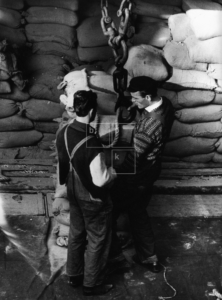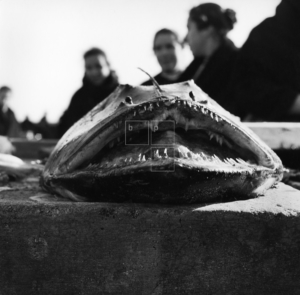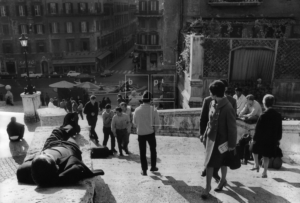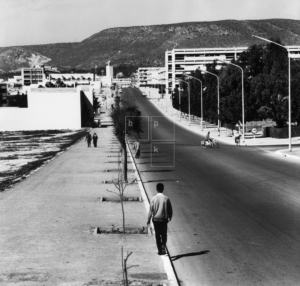Photo films
PHOTO FILM – THINKING IN SEQUENCES
Gerd Roscher in a conversation with Leonore Mau (2006)
Gerd Roscher (GR): It is extremely unusual for two artists to collaborate, with each one working in their own terrain while continually consulting one another and banding together. How should we imagine your cooperation, the collaboration between Hubert Fichte and yourself? How did your joint photo films come about?
Leonore Mau (LM): We had been already living here for a while when we were invited to a festive dinner at Hamburg’s Übersee-Club (Overseas Club). Seated opposite us was a couple who drew us into conversation. And suddenly the woman asked, “Tell me, where in fact do you live?” And we replied, “We live in Dürerstrasse 9”. “What?” she said, “We live in number eight.” In the house directly opposite you. The man was head of films at the NDR [Norddeutscher Rundfunk: North German television]. They invited us to dinner one evening and then the man, Reinhard Hagen, began saying how much he would like to broadcast photo films. Hubert said, “Photo films. We can do that, right off.” Without asking me. So then we discussed it at length when we got back home. I hadn’t the slightest idea how technically such photo films are made.
Then we went on a short holiday to Greece. On the last day but one we ate something that was off and Hubert came down pretty badly with hepatitis. The doctor said, “You may talk as much as you like, but avoid doing anything physical. You must stay in bed or go into hospital.” So Hubert then asked me, “Are you willing to take care of me, like make mashed potato every day?” I will never make so much mashed potato in my life again. But alright, that’s what I did. During that time we talked about the film. He said, “You need about 500 photos for a twenty-minute film. So you can go out every day. I can lie here alone in bed, and when you return you make mashed potato for me.” So that’s what we did: for weeks on end I set off in the morning. I photographed the world of dockworkers without a regular job and went to the “auction” every morning. They are really poor devils because in some circumstances they go there every morning in the hope of getting hired that day. But that doesn’t always happen. Finally, the boss of this place said to me, “Please come with me to my office after the auction. Because they don’t like photographs being taken during the auction, it makes them aggressive.” For half an hour I sat with the boss, after which he accompanied me back onto the street. That’s when my work began, properly getting to know people like that and seeing how they lived.
One woman had just had a baby and her husband would say goodbye each morning. Some of them were living in really poor conditions. I kept going back to these neighbourhoods and photographed the houses and the people when they went shopping. And then in Hamburg harbour. I told myself I had to go along with them, to one of those big ships. But how was I to get there? They were pleased that someone wanted to accompany them. I crossed over with them to a big ship in a sort of rusty old launch. When I arrived I was supposed to climb up on board the ship, up a rusty old ladder. As I ascended, one camera was dangling behind me, one in front. I felt utterly wretched. But I thought: you’ve got yourself into this, and you’ve also still got that mashed potato to make. So I clambered up this rusty ladder. Oh God, I was so horribly afraid. I don’t have a head for heights. But all of a sudden I was up there on the ship, between sacks of sugar and I don’t know whatever else was there. And the next moment I was busy working and that made me feel much better. I enjoyed that. I have no idea how many hours I was up there on the ship when it occurred to me I had to get back down again. But I managed that too without falling into the Elbe.
GR: Did your films generally come about with your photos already shot and Hubert then writing a commentary afterwards? Or did he sometimes also make specifications, like: I am interested in this or that, I would like you to shoot such and such a sequence?
In your Portuguese film Der Fischmarkt und die Fische (D, 1968) it feels as if he already had certain things in mind.
LM: Yes, making the Portuguese film was so exciting. It was all my own doing. Almost all of it was in my hands. I was able to slide around on my knees and point the camera right into the fishes’ jaws. But making the first film – Der Tag eines unständigen Hafenarbeiters (D, 1966) – was entirely different. Here, I initially had no idea at all what I was supposed to photograph. But Hubert was very animated. He was really pleased with the results. He then wrote the text and the film was shown. The people at the NDR were also very impressed and said, “If you find a subject like that again, just do it.” And the subject was Portugal and was the fish.
Links to the photo films (extracts):
- Der Tag eines unständigen Hafenarbeiters
- Der Fischmarkt und die Fische
- Die Spanische Treppe
- Zwei Mal 45 Bilder / Sätze aus Agadir
Untitled (Dockworkers with sacks), 1966
© bpk / S. Fischer Stiftung / Leonore Mau
Fischmaul, 1964
© bpk / S. Fischer Stiftung / Leonore Mau
Untitled (On the Spanish Steps), 1967/68
© bpk / S. Fischer Stiftung / Leonore Mau
Untitled (Street scene in Agadir), 1970
© bpk / S. Fischer Stiftung / Leonore Mau






